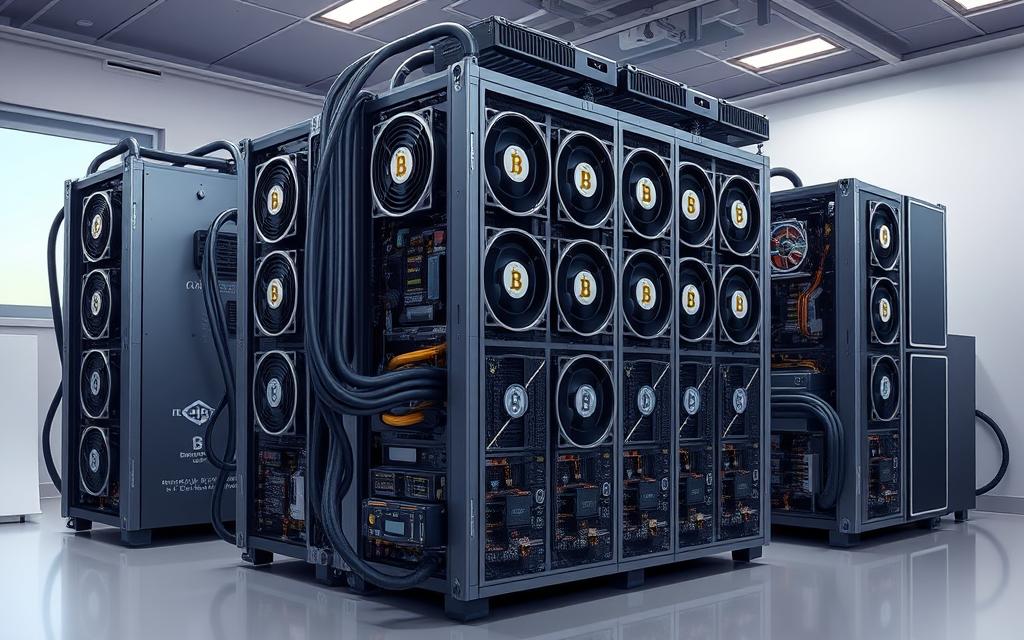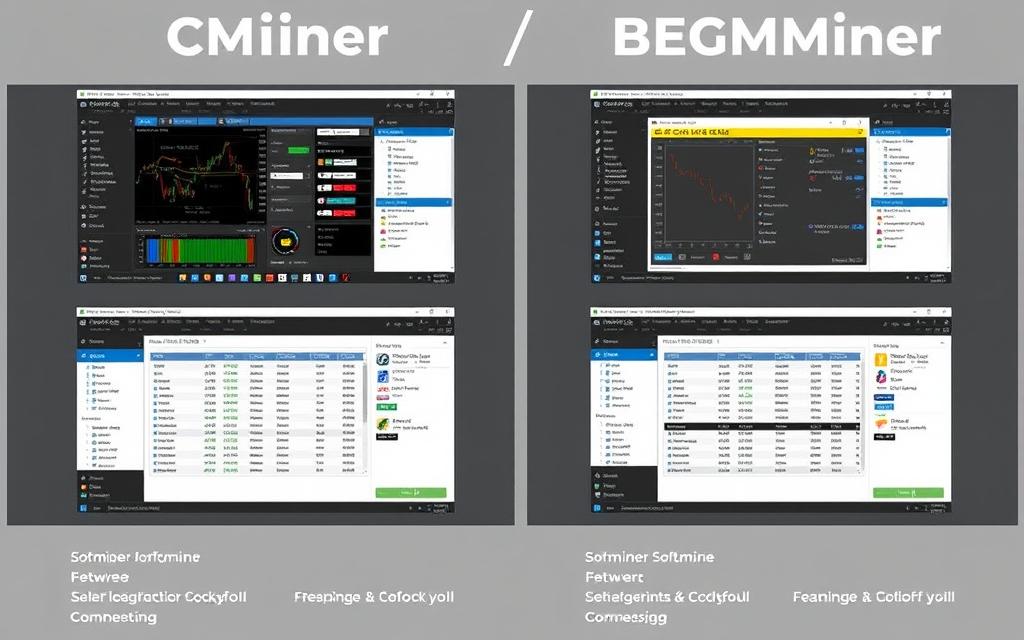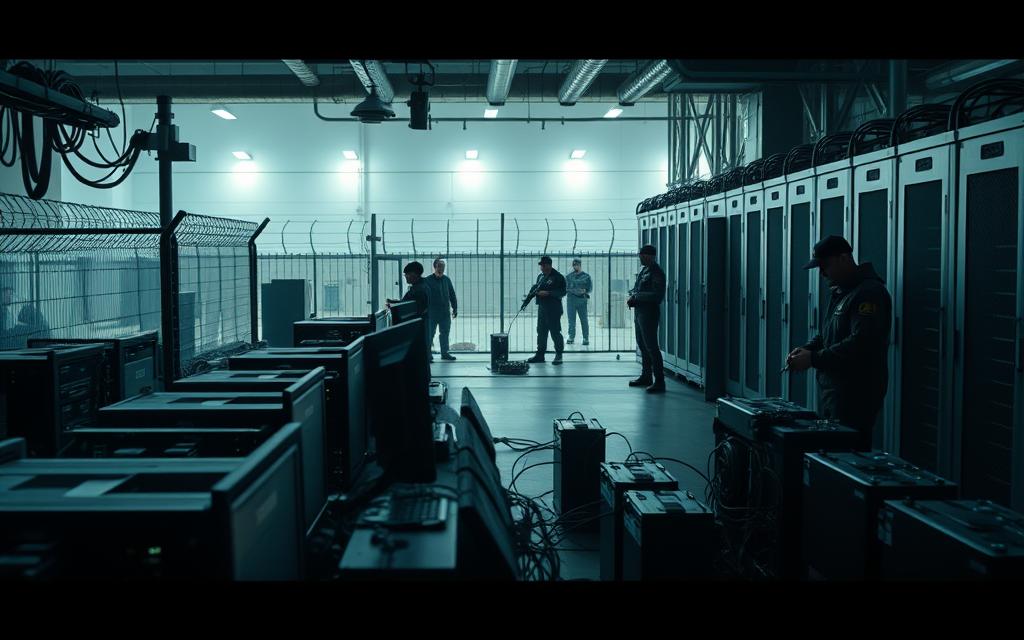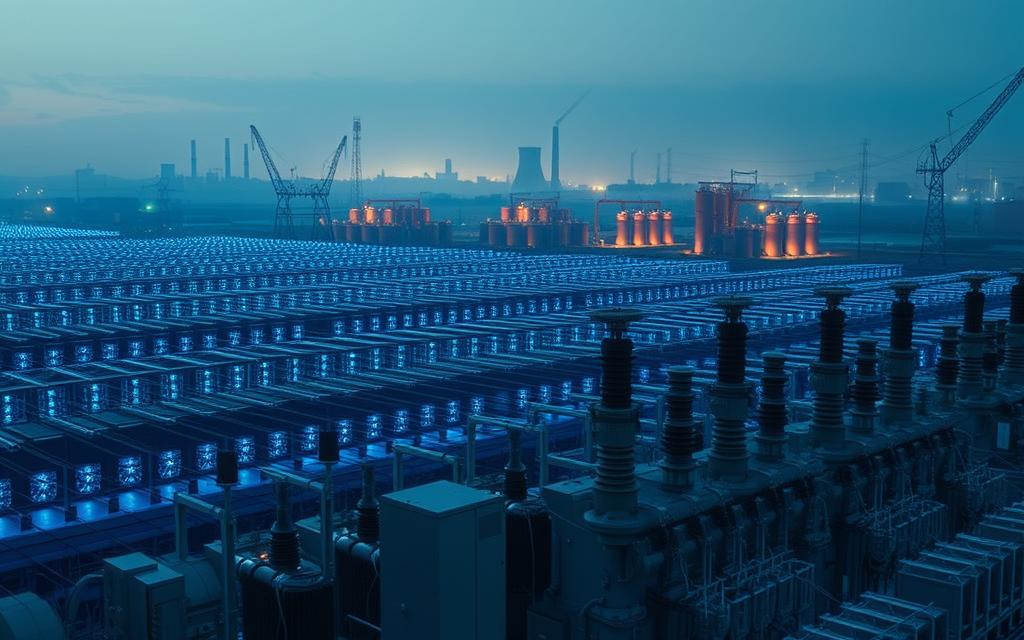Table of Contents
The process of Bitcoin mining is crucial for introducing new bitcoins into circulation and verifying transactions on the blockchain. Miners use powerful computers to solve complex math problems, validating transactions and securing the network.
This comprehensive guide will walk you through the mining process, from understanding the fundamental concepts of cryptocurrency and blockchain technology to setting up your own mining operation. You’ll learn about the necessary hardware and software, different mining methods, and key considerations like profitability and security.
By the end of this guide, you’ll be equipped to start your Bitcoin mining journey, making informed decisions about your crypto endeavors.
Understanding Bitcoin and Blockchain Technology
At the heart of Bitcoin lies a revolutionary technology known as blockchain, which enables secure and transparent transactions. To fully comprehend the process of Bitcoin mining, it’s crucial to understand the fundamentals of both Bitcoin and the blockchain technology that supports it.
What Is Bitcoin?
Bitcoin is a decentralized digital currency created in 2009 that operates without a central authority, allowing for peer-to-peer transactions without intermediaries like banks. It allows for direct online payments, potentially lowering transaction fees compared to traditional online payment mechanisms. The value of Bitcoin is determined by market demand, leading to its price volatility.
How Blockchain Works
The blockchain serves as a public ledger, recording all Bitcoin transactions across a network of computers. It functions as a distributed ledger that is transparent and immutable. Each block in the blockchain contains a batch of transactions, and once added, these records become a permanent part of the ledger, creating a secure and verifiable history.
The Role of Miners in the Bitcoin Network
Miners play a crucial role in the Bitcoin network by validating transactions and adding them to the blockchain through a process called mining. The Bitcoin network relies on consensus mechanisms to ensure all participants agree on the state of the blockchain, with miners competing to solve complex mathematical puzzles to earn the right to add new blocks.
The Basics of Bitcoin Mining
At its core, bitcoin mining is the mechanism through which transactions are validated and added to the public ledger, known as the blockchain. This process is fundamental to the operation of the Bitcoin network.
What Is Bitcoin Mining?
Bitcoin mining serves two primary purposes: validating transactions on the network and introducing new bitcoins into circulation according to a predetermined schedule. Miners compete to solve complex mathematical puzzles using computational power, with the winner earning the right to add the next block to the blockchain.

Proof-of-Work Explained
The proof-of-work consensus mechanism is used by the Bitcoin network to validate transactions and create new blocks. It requires miners to solve complex mathematical problems that demand substantial computational power, thereby securing the network.
Mining Rewards and Incentives
Miners are incentivized through block rewards (currently 3.125 bitcoins per block) and transaction fees paid by users to prioritize their transactions. This reward structure motivates miners to continue validating transactions and securing the network.
Essential Equipment for Bitcoin Mining
Bitcoin mining requires specialized equipment for optimal performance. The right hardware is crucial for successful mining operations.

ASIC Miners
Application-Specific Integrated Circuit (ASIC) miners are the gold standard for Bitcoin mining. They offer superior performance and energy efficiency compared to general-purpose hardware. Popular ASIC models include the Antminer series from Bitmain and the Whatsminer series from MicroBT.
ASIC miners are designed solely for mining and provide significantly higher hash rates. Models like the Antminer S19 Pro and Whatsminer M30S++ are highly efficient but limited to mining Bitcoin and a few other cryptocurrencies.
GPU Mining: Is It Still Viable?
Graphics Processing Unit (GPU) mining for Bitcoin is no longer economically viable due to the dominance of ASICs. However, GPUs remain useful for mining other cryptocurrencies that use different algorithms.
Power Supply and Cooling Solutions
Proper power supply units (PSUs) are critical for mining operations, delivering stable, continuous power while maintaining efficiency to minimize electricity costs. Effective cooling solutions are also essential to prevent overheating and maintain optimal performance.
Options range from enhanced airflow systems to immersion cooling for large-scale operations. The initial investment in mining hardware can be substantial, making it important to calculate potential returns before committing.
Required Software for Mining Bitcoin
Bitcoin mining requires specific software that enables your mining hardware to participate in the validation process. This software is the critical link between your mining equipment and the Bitcoin network, allowing you to contribute to the blockchain and receive rewards.

Mining Software Options
Popular mining software includes CGMiner and BFGMiner, both of which are open-source programs that support a wide range of mining hardware. CGMiner is known for its compatibility with various mining devices, while BFGMiner offers advanced features for monitoring and managing your mining operation. For beginners, more user-friendly options like EasyMiner or NiceHash might be preferable due to their graphical interfaces.
Bitcoin Wallets for Storing Rewards
A secure Bitcoin wallet is essential for storing your mining rewards. You can choose from hardware wallets like Ledger Nano X or Trezor Model T, which offer the highest security for long-term storage, or software wallets like Electrum or Exodus, which provide a balance of security and convenience. Hardware wallets store your private keys offline, protecting your assets from online threats.
How Do I Mine Bitcoin: Step-by-Step Process
Embarking on the journey of Bitcoin mining requires a systematic approach to ensure success. The process involves several critical steps that must be executed correctly to mine Bitcoin effectively.
Setting Up Your Mining Hardware
Begin by setting up your ASIC miner in a well-ventilated area with access to stable power and internet connections. Ensure that your power supply meets the requirements of your mining device to prevent damage or inefficiency.
Installing and Configuring Mining Software
Download mining software from official sources to avoid malware risks. Popular options include CGMiner, known for its reliability and extensive feature set. Configure the software by entering your Bitcoin wallet address and adjusting settings like fan speed and power consumption for optimal performance.
Connecting to a Mining Pool
Create an account with a reputable mining pool like Slush Pool, F2Pool, or Antpool. Configure your mining software with the pool’s connection details, including the server address and port number. This step is crucial as solo mining is rarely profitable for individual miners in today’s competitive environment.
| Mining Pool | Fees | Payout Structure |
|---|---|---|
| Slush Pool | 2% | Pay Per Last N Shares (PPLNS) |
| F2Pool | 2.5% | PPLNS |
| Antpool | Variable | PPLNS, Pay Per Share (PPS) |
By following these steps, you can set up a functional Bitcoin mining operation. It’s essential to monitor your setup’s performance, adjusting as necessary to optimize your mining process.
Different Mining Methods Compared
Bitcoin mining can be approached through various methods, each with its own advantages and disadvantages. The choice of mining method depends on factors such as computational power, investment capacity, and risk tolerance.
Solo Mining
Solo mining involves attempting to mine blocks independently, competing against the entire Bitcoin network with your own computational resources. While solo mining offers the full block reward (currently 3.125 BTC plus transaction fees) when successful, the chances of finding a block are extremely low unless you possess enormous mining power.
Pool Mining
Pool mining combines the computational resources of multiple miners, increasing the collective chance of solving blocks and providing more regular, albeit smaller, payouts to participants. In mining pools, rewards are distributed based on each miner’s contributed work (shares), with various payout methods like Pay-Per-Share (PPS) or Pay-Per-Last-N-Shares (PPLNS) determining how rewards are calculated.
Cloud Mining Services
Cloud mining allows individuals to participate in Bitcoin mining without owning or operating hardware by purchasing mining contracts from companies that manage the equipment. While cloud mining eliminates the need for technical knowledge and upfront hardware investment, it often comes with high fees and contractual risks.
| Mining Method | Advantages | Disadvantages |
|---|---|---|
| Solo Mining | Full block reward, complete control | Low chances of success, high resource requirement |
| Pool Mining | Regular payouts, combined computational power | Shared rewards, potential pool fees |
| Cloud Mining | No hardware maintenance, accessible to anyone | High fees, contractual risks, less control |

Calculating Mining Profitability

The profitability of Bitcoin mining depends on several key factors that need to be carefully evaluated. Earnings from Bitcoin mining vary widely based on hardware efficiency, electricity costs, and Bitcoin’s market price.
Hash Rate and Mining Difficulty
Your mining hardware’s hash rate and the current mining difficulty are crucial in determining profitability. A higher hash rate increases your chances of earning mining rewards, while mining difficulty adjusts every two weeks to maintain a consistent block time of 10 minutes.
Electricity Costs and Efficiency
Electricity costs are a significant ongoing expense for miners. Profitable operations typically require access to electricity rates below $0.10 per kilowatt-hour. Energy efficiency, measured in joules per terahash (J/TH), indicates how much electricity your mining hardware consumes relative to its hash rate.
Using Mining Calculators
Online mining calculators like those offered by CryptoCompare or WhatToMine allow you to input your specific parameters to estimate potential profitability. These calculators provide estimates based on current conditions, but actual returns may vary due to factors like difficulty increases and Bitcoin price volatility.
Optimizing Your Mining Operation
To achieve profitability in Bitcoin mining, it’s crucial to optimize your mining operation by focusing on key factors such as hash rate and energy consumption. A well-optimized operation can significantly improve your bottom line.
Maximizing Hash Rate
Maximizing your mining hardware’s hash rate is essential for improving mining efficiency. This can be achieved through firmware updates and cautious overclocking. However, overclocking should be approached with caution as it can reduce equipment lifespan and void warranties.
Reducing Energy Consumption
Undervolting your mining equipment can significantly reduce energy consumption while maintaining most of your hash rate, thus improving overall efficiency and profitability. Ensuring your electrical infrastructure can handle the power demands is also crucial.
Cooling and Maintenance
Implementing efficient cooling solutions is critical to prevent overheating, which can lead to reduced performance or permanent damage. Regular maintenance, including cleaning dust from fans and heat sinks, is also vital. For larger operations, immersion cooling can provide superior cooling efficiency.

Bitcoin Mining Pools: Choosing the Right One

In the competitive realm of Bitcoin mining, joining a mining pool can be a game-changer for individual miners. By combining their computational power with others, miners can increase their collective chance of solving blocks and earning more consistent rewards.
Top Mining Pools in 2024
As of 2024, leading Bitcoin mining pools include Foundry USA, AntPool, F2Pool, and Binance Pool. Each of these pools offers different features, fee structures, and payout methods. When selecting a pool, consider factors like pool size, reputation, server locations, and historical performance.
Pool Fees and Payout Structures
Pool fees typically range from 0% to 3% of mining rewards. Different payout structures, such as Pay-Per-Share (PPS) and Pay-Per-Last-N-Shares (PPLNS), affect how and when you receive rewards. Understanding these structures is crucial for maximizing your earnings in the crypto network.
By choosing the right mining pool and understanding its fees and payout structures, miners can optimize their operations and improve their profitability in the Bitcoin mining landscape.
Security Considerations for Bitcoin Miners
Effective security for bitcoin miners encompasses a range of strategies, from securing mining hardware to protecting wallet credentials and network communications. A comprehensive security approach is crucial to prevent potential threats and losses.
Protecting Your Mining Hardware
Physical security for your mining hardware is essential. This includes measures like secure facility access, surveillance systems, and protection against theft. Implementing proper electrical safety measures, such as circuit breakers and surge protectors, is also vital to protect your equipment and prevent fire hazards.
Securing Your Bitcoin Wallet
Secure your Bitcoin wallet using hardware wallets like Ledger or Trezor for long-term storage of mining rewards. These wallets keep private keys offline, protecting them from online threats. Regularly update your wallet software to ensure you have the latest security features, and securely store your recovery phrase.
Network Security Best Practices
To secure your network, use a VPN when connecting to mining pools, implement strong Wi-Fi encryption, and keep your router firmware updated. Enable multi-factor authentication (MFA) for all accounts related to your mining operation, and be vigilant against phishing attempts targeting miners.

Legal and Regulatory Aspects of Mining
The legal landscape for Bitcoin mining varies significantly across different jurisdictions. In the United States, for instance, Bitcoin mining is generally considered legal, but the regulatory environment differs from state to state.
Bitcoin Mining Laws in the United States
While Bitcoin mining is legal in the U.S., various states have enacted different regulations. Some states, such as Texas, Wyoming, and Kentucky, have introduced legislation favorable to miners, offering incentives like tax breaks and access to affordable energy.
| State | Regulatory Environment | Incentives |
|---|---|---|
| Texas | Favorable | Tax incentives, affordable energy |
| Wyoming | Favorable | Tax exemptions, business-friendly laws |
| Kentucky | Favorable | Tax incentives, energy subsidies |
Tax Implications for Miners
The IRS considers mined Bitcoins as taxable income, valued at their fair market value at the time of receipt. Miners must keep accurate records to comply with tax regulations. When selling mined Bitcoins, miners may incur capital gains tax on any appreciation in value.
Tax Considerations for Miners:
- Mined Bitcoins are considered taxable income
- Capital gains tax applies when selling mined Bitcoins
- Deductions available for equipment depreciation and operational expenses

Environmental Impact and Sustainable Mining
Bitcoin mining’s substantial energy usage has raised concerns about its environmental footprint. The process requires significant amounts of electricity to power the specialized hardware needed for mining, leading to a considerable carbon footprint.
Energy Consumption Concerns
The Cambridge Bitcoin Electricity Consumption Index estimates the total Bitcoin electricity consumption for 2023 to be 121.13 TWh, about 0.44% of global demand for electricity. The environmental impact varies greatly depending on the energy sources used; mining operations powered by coal or other fossil fuels contribute significantly to carbon emissions.
Renewable Energy Solutions for Miners
Many mining operations are relocating to regions with abundant renewable energy sources like hydroelectric, solar, or wind power to reduce their environmental footprint. Some miners are implementing innovative solutions, such as capturing excess natural gas from oil fields or utilizing excess energy from renewable sources during low-demand periods.
| Renewable Energy Source | Potential Impact |
|---|---|
| Hydroelectric Power | Significant reduction in carbon emissions |
| Solar Power | Lower operational costs, reduced environmental impact |
| Wind Power | Decreased reliance on fossil fuels, lower emissions |

Common Challenges and How to Overcome Them
Bitcoin mining operations face numerous challenges that can impact profitability and efficiency. These challenges range from hardware failures to market volatility and increasing mining difficulty.
Hardware Issues and Troubleshooting
Hardware failures are a significant challenge for Bitcoin miners, with issues like overheating and power supply problems causing costly downtime. Implementing preventative maintenance schedules and keeping spare parts on hand can minimize the impact of these issues. Regular monitoring can help identify potential problems before they become critical.
Dealing with Market Volatility
Bitcoin’s price volatility directly affects mining profitability, with significant price drops potentially rendering operations unprofitable. Miners can address this by implementing hedging strategies, such as using futures contracts or converting mined Bitcoins to stablecoins. This helps stabilize revenue despite market fluctuations.
Adapting to Increasing Mining Difficulty
The continuous increase in mining difficulty requires regular hardware upgrades to maintain profitability. Miners must plan for equipment obsolescence, typically expecting to replace or upgrade hardware every 18-36 months. Staying ahead of the curve with the latest mining technology is crucial for remaining competitive.
| Challenge | Impact | Mitigation Strategy |
|---|---|---|
| Hardware Failures | Costly Downtime | Preventative Maintenance |
| Market Volatility | Unprofitable Operations | Hedging Strategies |
| Increasing Difficulty | Reduced Profitability | Regular Hardware Upgrades |

Conclusion
Bitcoin mining stands at the intersection of technology, economics, and energy management, playing a crucial role in the cryptocurrency’s ecosystem. The mining process involves verifying transactions and creating new blocks, which are essential for the security and decentralization of the Bitcoin network.
While Bitcoin mining can be profitable, it requires careful consideration of hardware selection, electricity costs, and ongoing management to remain viable. The industry continues to evolve, with advancements in hardware efficiency and renewable energy integration shaping its future. For those interested in exploring other cryptocurrency options, there are new cryptocurrencies emerging that offer alternative mining opportunities.
In conclusion, the world of Bitcoin mining is complex and challenging, yet it remains vital for the blockchain‘s integrity. As the ecosystem matures, mining will continue to adapt, providing a mechanism for transaction verification and rewards issuance. Understanding this process offers valuable insights into the revolutionary technology behind crypto currencies.
FAQ
What is the role of miners in the Bitcoin network?
Miners validate transactions, create new blocks, and secure the blockchain by solving complex mathematical problems, thereby maintaining the integrity of the Bitcoin network.
What is the block reward and how is it earned?
The block reward is the number of new Bitcoins awarded to a miner for successfully validating a block of transactions and adding it to the blockchain. Miners earn the block reward by solving complex mathematical problems.
What is mining difficulty, and how does it affect mining?
Mining difficulty is a measure of how hard it is to solve the complex mathematical problems required to validate a block. As more miners join the network, the mining difficulty increases, making it harder to mine new Bitcoins.
What are the benefits of joining a mining pool?
Joining a mining pool allows miners to combine their computational power, increasing their chances of solving complex mathematical problems and earning rewards. This can lead to more consistent and predictable earnings.
How do electricity costs affect mining profitability?
Electricity costs are a significant expense for miners, as they require substantial power to operate their mining hardware. High electricity costs can reduce mining profitability, making it essential to optimize energy efficiency.
What is the environmental impact of Bitcoin mining?
Bitcoin mining consumes significant amounts of energy, contributing to greenhouse gas emissions and environmental concerns. However, some miners are exploring renewable energy solutions to mitigate this impact.
How do transaction fees affect mining rewards?
Transaction fees are paid by users to prioritize their transactions. Miners earn these fees in addition to the block reward, increasing their overall rewards.
What is the importance of hash rate in mining?
Hash rate measures a miner’s computational power, which determines their ability to solve complex mathematical problems. A higher hash rate increases a miner’s chances of earning rewards.









